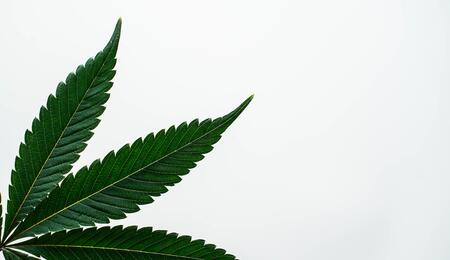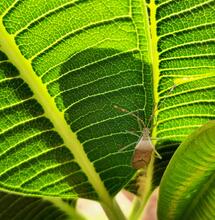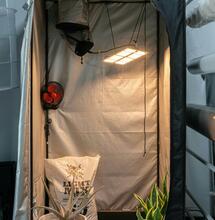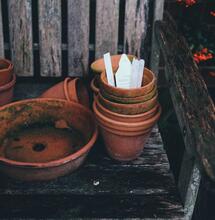Over-fertilisation. What to do? You can still save the day!

There are various opinions on how to fertilise best. A few growers fertilise too little, others too much. Out of caution, it’s better to fertilise less, as plants totally absorb fertiliser in this case. When too much fertiliser is used, plants can be damaged, or may even die. If plants fertilised beyond a critical limit are harvested, the quality would be so bad that you will not even be able to give them away for free. Virtually any fertiliser - not merely a broad-spectrum fertiliser but also individual components or additives – could be used in excessive quantities. Depending on which substances critically overcome the threshold value, the effects on plants will vary. There are therefore no general indications that would tell you that an ingredient is present in a critically high proportion in the substrate.
A few indications are leaves losing colour or getting rolled up. Depending on genetics, however, the dying-off of large leaves could be pretty normal. When little light is received in the lower parts, at the end of bloom period, leaves turn purple. Therefore it is important to correctly interpret symptoms for a peculiar type of genetics, as in some situations the plant could be perfectly vital. However, if one or a few ingredients are fed in a critically excessive proportion, the plant will first start to suffer, then stop growing and finally wither.
Over-fertilisation is a delicate topic. When fertiliser manufacturers recommend EC values, their indications relate to genetics that can withstand a large fertiliser quantity. However there are also old strains or special Haze genetics that are fertilised beyond acceptable limits despite these ‘normal’ indications. A grower therefore cannot safely say that, during the bloom period, a range of 1.4 to 2.2 EC is usually ok for fertilisation.
This can either be right or wrong. What counts is to gather information on the selected genetics before growing a plant and monitor how the various indicators perform during its growth. In certain situations, the indications of fertiliser manufacturers could be wrong even for genetics that can withstand a large quantity of fertiliser.
If a grower operates a hydroponic system with 20% drainage, which washes the fertiliser away and this 20% is not even observed and no effective drainage is made, the fertiliser may easily become absorbed and accumulate in the growing substrate (i.e. stone wool or CoGr). Or the grower may operate a recirculation system, in which used water is recovered and reused for further watering. The crop will more rapidly absorb water than fertiliser, which will accumulate in the water tank.
The EC value in the remaining water may rise and overcome a critical threshold. There are growers who have simply put stone wool into pots, without protecting them against evaporation. Evaporation was so high that plants were already over-fertilised long before harvest and they finally withered. Depending on the specific situation, fertilisation should also be adjusted independently of the plant genetics.
Growers who notice the effects of over-fertilisation invariably make a typical mistake, i.e. they totally suspend fertilisation. If signs of over-fertilisation are visible, normally this means that fertilisation has already reached a critical stage, whereby the plant ends up being damaged and its growth stops. At this stage, if the plant is further irrigated with PH-adjusted water and the plant growth has already stopped, it can no longer take the fertiliser from the substrate in order to gain a green colour.
The plant will remain in an over-fertilised substrate, will not be able to overcome the problem and therefore will remain impaired. The problem will therefore not be solved and, if the grower uses tap water with the typical EC value of drinkable water, he will also add nutrient salts and worsen the situation even more. Suspending the fertiliser may only help if over-fertilisation has not reached the critical limit. Beyond that limit, the substrate shall be rinsed with PH-adjusted water at a suitable room temperature. If fertiliser traces are washed away from the soil, the plant can again become vital. This technique also functions if the critical value for a single substance is overcome.
Even if the grower has wrongly interpreted a given situation and fed an excessive quantity of this substance, rising will not be a bad solution if the substrate is later fertilised normally - provided that a good broad-spectrum fertiliser is used, in which the ingredient is contained in a small quantity, that the grower has not further worsened the situation, and that the ingredient has not been dissolved (often fertilisation is done in the wrong way, the wrong fertiliser is used or the fertiliser is fed in the wrong dosage).
It is also not a bad idea to rinse the substrate if there is a suspect of over-fertilisation, even if it is not necessarily true. If, on the other hand, over-fertilisation has reached a critical stage, then the grower should use at least as much water for rinsing as required to equal the volume of the substrate. If water coming out of the substrate is visibly coloured, this is an indication of over-fertilisation. After rinsing water should come out only slightly coloured. When water becomes again clear, this means that plants again need fertilisation.
Depending on the fertiliser used and the degree of over-fertilisation, water may look differently at the beginning and at the end of rinsing. It can even be clear right from the start. On the other hand, if even a single substance has been fed above the critical threshold, rinsing is indispensable. In any case, growers should use complete (i.e. broad-spectrum) fertilisers and avoid using nutrients individually, as they will most likely tend to make errors and frequently forget the indispensable trace elements.
The EC value can also be measured in drainage water exactly as it is measured in irrigation water. Since, normally, EC accumulates in the substrate, the EC value is generally higher in drainage water then in irrigation water. This is not negative but rather normal and even beneficial. However, it should be considered that a given type of genetics only tolerates a specific EC value in the substrate. Growers can easily assess these values by performing measurements in drainage water.
If they have assessed for their genetics that a value of e.g. 2.6 is tolerated, above which it would be too much, and a value of 2.2 has already been reached, this means that irrigation water should be less fertilised in order to avoid later rinsing. Significantly, plants that are forming roots or growing need a lower EC value in the substrate in order to properly develop. Growers who reuse stone wool, CoGr or soil are required to rinse them thoroughly three days before harvest, for a plant to mature healthily and for the substrate to be perfectly reusable with a low EC.



.png)